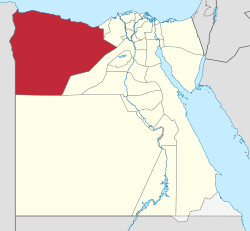Top Qs
Timeline
Chat
Perspective
Matrouh Governorate
Governorate of Egypt From Wikipedia, the free encyclopedia
Remove ads
Matrouh (Arabic: محافظة مطروح, romanized: Muḥāfaẓat Maṭrūḥ) is a governorate in north-western Egypt. It borders Libya, and its capital is Marsa Matrouh.

Remove ads
Municipal divisions
The governorate is divided into municipal divisions with a total estimated population as of January 2023 of 538,546.[2]
Remove ads
Overview
The interior of the Matrouh Governorate is part of Egypt's Western Desert, including the Siwa Oasis, in antiquity known for its shrine to Amun. In the center of the Governorate is the Qattara Depression, descending to 133 metres below sea level.
Marsa Matrouh is the ancient Koine Greek: Παραιτόνιον Paraitónion, Latin Paraetonium. It was the westernmost city of the Ptolemaic Kingdom in the Hellenistic period. The city of Apis, some 18 km to the west of Paraetonium, marked the boundary to Libycus nome, and the Halfaya Pass (at Sallum) marked the boundary to Marmarica proper.
Matrouh Governorate contains many historical sites related to World War II. The latter include el Alamein, which comprises cemeteries of fallen soldiers from Axis and Allied forces. An estimated 16 million mines,[5] planted by the Europeans during the world wars and called "devil's gardens", still hinder the development of most of the governorate, and are constantly being removed.
Remove ads
Population
According to population estimates, in 2015 the majority of residents in the governorate lived in urban areas, with an urbanization rate of 70.6%. Out of an estimated 447,846 people residing in the governorate, 316,005 people lived in urban areas as opposed to only 131,841 in rural areas.[6]
Industrial zone
According to the Governing Authority for Investment and Free Zones (GAFI), the following industrial zones are located in Matrouh:[7]
References
External links
Wikiwand - on
Seamless Wikipedia browsing. On steroids.
Remove ads




